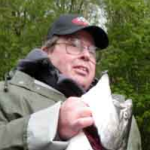King of the Reach Recap
Would you pay $25 to fish “closed waters” and catch huge Kings like the one pictured below all day long?
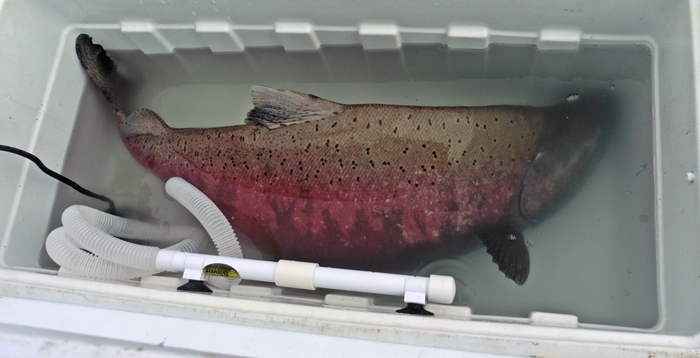
A huge “Upriver Bright” approaching 40 pounds!
Last Friday my friend Scott, from the Auburn chapter of Puget Sound Anglers, and I participated in the “King of the Reach” Salmon Derby. This Derby is jointly sponsored by the Department of Fish & Wildlife (WDFW), Grant County PUD and the Tri-Cities Chapter of the Coastal Conservation Association (CCA). The purpose of the Derby is the live capture of “unmarked” adult Kings, so that they can become part of the WDFWs brood stock program. The goal of the brood stock program is to increase the gene pool used in the production of hatchery Kings.
However, these are not just any King Salmon – these are the famed “Upriver Brights” (URBs). URBs are King salmon that predominantly spawn at or above the Hanford Reach area of the Columbia. These fish are known for their extremely large size, some reaching over 50 pounds! Additionally, these Kings are extremely strong because they have to fight their way back up the Columbia all the way to their spawning grounds. Genetically, they have adapted to this long journey from the ocean and ,while their skin colors up, their meat stays in prime shape into October.
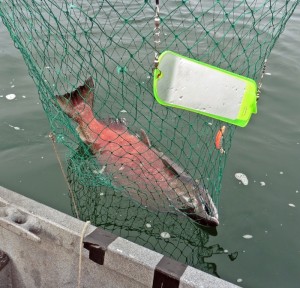
Fish in the net!
The White Bluffs boat launch at the old ferry landing is a short 160 miles from our meeting place in North Bend. Most of the way the speed limit is 70 miles per-hour on the interstate and 55 miles per-hour on the state routes, so we were able to make it there in less than 3 hours. One word of caution is that, if you have never been there before, when on SR-24, slow down well in advance of the turn off into the Hanford Reach National Monument. Watch for Mile Post 63, and the right turn is about two tenths of mile past that. There is also small sign on the side of the road but I cannot see it in the dark.
We arrived before daylight because the best bite is early in morning. However, we need not have been worried because there were lots of fish there and they bit all day!
Also, if you have never fished a derby in eastern Washington before you are in for a real treat. The people there are really friendly and there was less than a dozen boats fishing, so the ramp was never crowded. Additionally, when you registered for the derby, they had muffins and candy to energize you to reel in lots these big fish! Then, later in the day, they brought you cooked gourmet hot dogs when you “landed” your fish. You never even had to get out of your boat – I have never seen that at a derby before!
The White Bluffs launch is paved and it is either a narrow two-lane launch or wide one-lane launch depending on traffic. When we were there people used it as a one-lane launch but I suspect that, when things are busier, it might become a two-lane launch. The area of the Columbia River around this launch is extremely easy to navigate with a boat with a prop if you are able to read river water. There is a “deep section” for a couple of miles, but if you want to venture beyond that, you will need a boat with a “pump.”
After launching, we ran downstream to the middle of the “deep section” and started to troll upstream. This is exactly the opposite of what we did in last year’s derby. Then,we stated in the head of the hole and back-trolled downstream using downriggers. The reason for the method change was this year there was a stiff wind blowing downstream and I felt that back trolling would be impossible for us. This change proved to be an excellent choice.
Our rigging method this year consisted of a “sliding” 12-ounce cannonball weight on 50-pound braid mainline. Then to our terminal swivel, we attached a 20-inch section of 50-bound mono. This is called a “bumper” and separates your weight from our Pro-Troll flasher. This separation allows the flasher to turn and also reduces tangles.
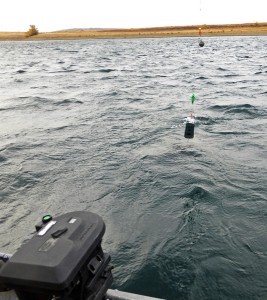
Our Pro-Troll and Brad’s Rig!
Like just about everyone else in eastern Washington, we used Pro-Troll flashers with Agitator Fin (it is called a Pro-Chip -11 flasher). Everybody at the Derby said that was the standard “go-to” flasher on the Hanford Reach because the Pro-Chip flasher with the Agitator Fin will rotate at speeds as slow as one mile an hour, while other flashers will only rotate at speeds at or above 1.8 MPH. This ability to rotate at slow speeds is the key to success.
Next, we attached the Brad’s Original Super Bait using a 45-inch leader of 30-pound mono using two barbless hooks. Then you open your Super Bait and fill it with your choice of baits. In our case it was canned tuna that is was packed in oil. Normally, you have to pull your gear and refresh your bait often. But as we were getting so many fish, they were hardly ever in the water long enough to need refreshing!
Most of our fish came on the Chrome with Stoplight Dots and, Glow Chartreuse, White Glow Pro-Chip 11 flashers. For the Brad’s Original Super Bait, the Hot Tamale or Hotter Tamale worked best. Additionally, we did get some fish on other color flashers and lures when we were “re-rigging” our gear. This year the fish were extremely aggressive in hitting our gear and we “re-rigged” a lot. We broke off more then I care to admit while fighting. Additionally, we sacrificed many leaders taking the fish out to the net to minimize injury so that they would live to spawn at the hatchery.
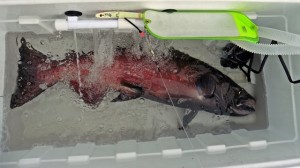
“Live well cooler”
Fishing for us was extremely hot for the first three hours of the morning. We had more fish on than I could keep track of! On one “troll” we had seven fish on in twenty minutes before we were able to get one into the net. I think we turned in 11 URBs, lost many more and released a number of clipped Kings. We also had numerous “double headers” thoughout the day. (Note: You can use your two- rod endorsement in this area. However, sometimes less is more. We had so much action, that two rods is all we could handle effectively.)
Once you get a fish into the net, you need to treat it gently. I do not have a live well in the boat but I brought 120-quart cooler and WDFW staff loaned an aerator pump with battery clips. Each time we caught a fish, we put fresh water in the cooler, turned on the pump and brought it directly to the weigh-station. There the sex of the fish was determined and it went immediately into the WDFW’s tanked truck for safekeeping until it was time to leave for the hatchery. (The fish were never weighed to keep handling to a minimum.)
This event you must put on your 2016 calendar because you will have a great time and meet a lot of nice people!
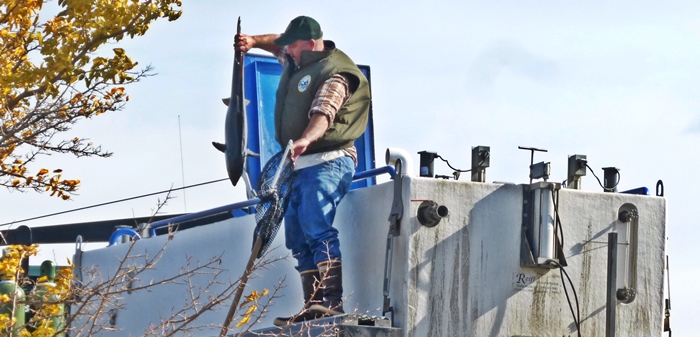
Mike Erickson from WDFW puts another URB is their tanker truck!


